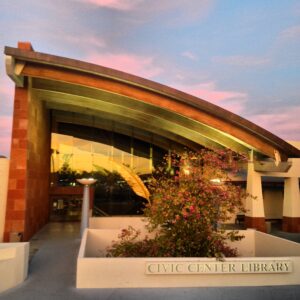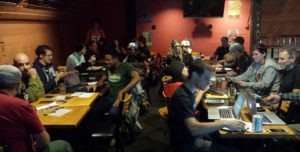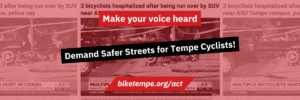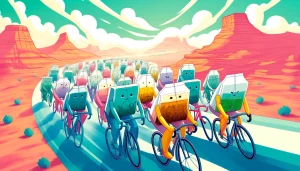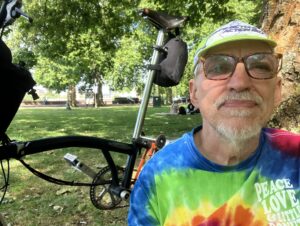Car-free & Carefree in Phoenix
Thinking about going car-free in Phoenix might seem like a daunting proposition, given the city’s sprawling layout and hot desert climate. However, with a growing emphasis on sustainable living and an increasing array of public transportation options, more residents are exploring the benefits of ditching their cars. In this post, we’ll delve into a Q&A session with Skitch, a local resident who recently embraced a car-free lifestyle in Phoenix. We hope that to provide you with inspiration for making the transition to a car-free life in the Valley of the Sun.
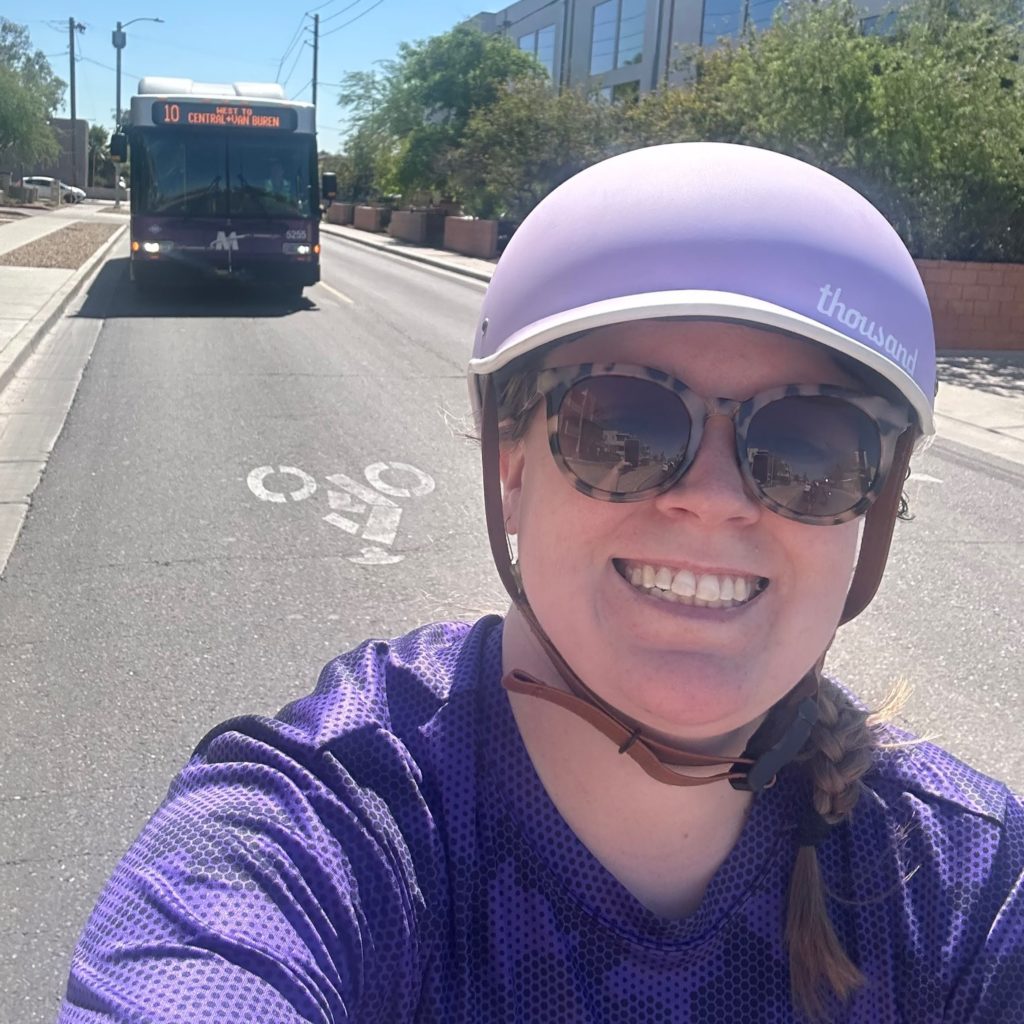
How long have you been car-free? I’ve been car-free since the beginning of 2024. For several years before that, I lived a car-light lifestyle—meaning I still had a car but didn’t depend on it for my primary transportation needs. When I was in college in Colorado (from 2017 to 2021), I stopped using my car frequently for a very silly reason: parking. None of the apartments I lived in came with a dedicated parking space, so using my car during the day often meant having to park it on a different street when I returned. The streets my apartments were on were some of the only free streets to park on in the area, so spaces filled up quickly.
During the pandemic, I began walking from my place in downtown Boulder to hiking trails about 1-1.5 miles away in one direction and to shopping destinations about a mile in the other direction. I also had a bike and lived a few blocks away from the central bus station, making it easy to catch a bus going to the college campus and return.
During my time in graduate school at ASU (from 2021 to 2023), I lived in Tempe at Broadway and Rural and continued to use my car sparingly. I chose to live near campus so I could get to class within a 10-minute bike ride and not worry about paying for parking on campus. As I settled in, I began to use light rail and buses more, and I started to commute to my internship (near the airport) by biking a mile to the light rail, taking the train, and then biking half a mile to my workplace. After my first year at ASU, I began to ask my parents to take my car back since I wasn’t using it much. They pushed back, worried I would regret my decision and still need a car, so I started to document my modes of transportation to show how little I was using my car. It only got driven once or twice a week to go hiking at South Mountain, go to my preferred grocery store, and go shopping.
After graduating, I moved from Tempe to downtown Phoenix with my partner, and we strategically chose an apartment that was close to a grocery store and along the light rail line so I could access my internship, which turned into a full-time job. Living downtown with a car meant having to pay for parking for the first time, which cost me $125 a month. I continued to track how often I drove and the reasons for driving, and the majority of the time, I was only driving to keep the engine running. I relied on my car to take me to South Mountain and to shop at places that were beyond downtown. I finally convinced my mom to take the car back, but the deal was that I would have to drive it to her house in South Florida. My partner and I made the 2,000-mile drive in three days before Christmas last year and flew back to Arizona, and that’s how I officially became car-free.
Why did you decide to give up your car? Aside from how infrequently I used the car, there were other benefits to giving it up. One was financial. I already mentioned how I was paying $125 a month to park my car in my building downtown, but there are so many other costs associated with car ownership. I owned my car, so I didn’t have car payments, but many people do, and this is a significant factor in the cost. Other costs include insurance (I paid $986 for my last eight months of car insurance, which comes out to around $125 per month), vehicle registration (I paid $378 for a year), gas (I spent at least $226 over eight months), and maintenance (I paid $250 over eight months). The eight-month period I am referencing with these numbers is from when I graduated from grad school to when I gave up the car. The money I spent on gas and maintenance is very low and would be much higher for someone who drives their car more often, like to work every day, to the grocery store weekly, etc. AAA estimates that Americans spend over $12,000 a year on new vehicles, which is a very large number that could be a burden on folks who make less than the median income. Alternatives to car ownership like biking, transit, and rideshare are not free, but they cost much less than $12,000.
Another reason I wanted to give up my car was to “talk the talk and walk the walk” as a professional. Both of my degrees are in urban planning, and transportation is my niche within planning. My first job out of school was as a transportation planner, mostly working on regional transportation plans that focused on roadways, and my new job is as a Transit Planner for the City. After learning about the harms of car dependency and personally experiencing the benefits of more sustainable transportation (walking, biking, public transit), I became very passionate about wanting to design our cities for people rather than for cars. I have chosen to live the lifestyle that I want to be more attainable for most Americans—not having to rely on a car for every transportation need. By showing that living car-free is possible, I hope to make sustainable transportation seem more legitimate to people who have doubts.
How do you get around now? I walk every day, so my spreadsheet would tell me this is my most used mode. We are all pedestrians at some point in our journey, whether it is walking the entire way, walking to our destination from where we parked our car or bike, or walking from a transit vehicle to a destination. However, I’ve actually been walking less since moving downtown (compared to when I lived in Tempe) because everything is closer together. Since starting my new job, I’ve primarily been walking to and from work twice a day since I’m close enough to go home for lunch. Now that it’s summer, I’m starting to bike more since it is two to three times faster and gives me a few extra minutes at home before I have to leave.
If I’m not walking somewhere, I’m pretty evenly split between biking and transit. I have three bikes, and I’m beginning to use them all frequently, but my most used bike is my Lectric 3.0. It gets me the furthest and is more flexible than transit when I’m taking trips out of downtown. I’m starting to use my Brompton more when I do trips that involve a transit component since it’s so easy to bring on a bus or a train. For example, to attend the TBAG Women/Trans/Femme ride in South Tempe, I brought my Brompton on the Light Rail, transferred to an Orbit, and biked the last mile.
For transit, I use the light rail most to go to Midtown/Uptown and to get to the airport/Tempe/Mesa. I don’t use the bus too often since the light rail often covers my transit needs, but sometimes I’ll use the Central Avenue buses instead of the light rail when the timing works out. Sometimes I will bring my Lectric on the South Central Avenue bus to go to South Mountain for Silent Sunday (when the main road is closed to car traffic) and ride to the summit or on San Juan Road. I’m trying to ride more buses since I have a goal to ride every bus in the Valley Metro System, and the Brompton will make this easier since I can reach bus lines further away from downtown.
I thought I would rely on rideshare more often since ditching my car, but there have only been a handful of times I’ve used it this year. I’ve also only gotten rides from friends or family members a couple of times, and only half of those trips were necessary to complete in a car.
What are some unexpected challenges you have faced? My biggest challenge has been transporting both of my cats. Recently, my apartment had a planned 24-hour power outage over a weekend, and we were warned months in advance that we would need to find somewhere else to stay. At first, my partner and I weren’t able to find someone to host us, so we planned to stay in a hotel. We ended up finding a place to stay with my partner’s sibling, and everything worked out—we could stay the full 24 hours, and we transported the cats to and from the sibling’s house via our e-bikes.
Another cat-related challenge is bringing my cats to the vet. Downtown Phoenix has almost everything I need, but several things are missing from the core, like a veterinary office. I got my cats their annual checkups at their old vet in South Tempe before I moved, but when medical concerns came up this year, I had to find a new vet. There is a vet on the north end of downtown on McDowell that is the closest to me, but they have had no availability for new patients since I reached out in February. The next closest vet in Midtown was also not accepting new patients, so I found another vet that was also in Midtown along a major road. I brought one of my cats there twice on my e-bike, but there was a problem—the vet had absolutely no bike parking! They wouldn’t let me bring the bike inside (like most places without bike parking usually do) because they were worried it would scare their dog patients. My bike did not get stolen (one of the times I had my partner wait outside with the bikes to keep an eye on them), but I had a friend get a bike stolen at the same intersection earlier this year, so I knew bike theft was present in the area. The vet on McDowell that I would love to get into has bike racks, so multiple times a week I am hoping that they call us back and tell us they can see us.
Other than taking care of my cats, the rest of my challenges have been minimal. A time I missed my car was when I was on a Critical Mass ride and got two flat tires on my acoustic bike at the same time, thanks to a pothole. I was in an area I was unfamiliar with and did not feel safe in, and I also did not have any tools to fix the two flats. I ended up calling a Waymo to bring me and the bike home, but I learned that Waymo back seats cannot be folded down. My partner and I finally jammed my bike in the backseat upside down, and I sat in the front seat while my partner rode his bike back to our apartment. I got home before he did and had to wrestle the bike out of the Waymo by myself, which took a few minutes.
Using transit and my e-bike to access hiking is a major shortfall of getting rid of my car, as it restricts me to trails I can access from the roads rather than from a parking lot within a mountain preserve. I have a goal to hike every trail on South Mountain, and most of my unfinished trails are off San Juan Road (the furthest points accessible by car). I brought my e-bike to the mountain one time to complete one of these trails and found a ramada I was planning on locking up to. When I reached the ramada site, the ramada had been torn down, and there was nothing to secure my bike to. The park does have a recently finished bike hub at the entrance of San Juan Road, but this hub is still at least a mile away from any unfinished trails I want to access, so it’s not much better than when I was limited to hiking where I could find parking for my car.
How has your life changed for the better? When I first got my license at 16, I loved driving around aimlessly and hanging out with my friends in my car. As I got older, I started to get stressed out by driving and experienced some road rage, like getting upset at people going “too slow” for me. I never acted on my road rage, but I became impatient and felt entitled as a driver. Something about driving does that to people, which doesn’t happen when you’re biking, riding a train or bus, or walking. I feel like not driving has improved my mental health and stress levels. I haven’t been behind the wheel of a car since December, and that feels great.
My life has also improved because I’ve been able to buy more bikes. I got my e-bike slightly before ditching my car, and I named her Carla because she is my new car. I used the money I got reimbursed for ending my car registration and insurance policy to buy an extended battery for Carla, an acoustic bike for group rides, and a Brompton for traveling and taking on transit with me.
Do you see the built environment differently than you did before? Since I’m an urbanist and a planner, I was already very aware of how much space in our cities is devoted to cars and car dependency, so going car-free didn’t change much of that. I have come to appreciate downtown Phoenix more, though, since I rarely leave it. I love living in a dense area and in such a central location because I am constantly running into people I know. These interactions on the sidewalk would never happen if I was in my car all the time. I am also learning multiple ways to get around and to reach certain destinations. For example, instead of just getting on the freeway and driving to the closest Target, I can now choose between taking my e-bike or a variety of transit routes to travel four miles north and 1.5 miles east. Another thing I’ve noticed is that freeways are mostly irrelevant to me now that I don’t use them to commute. For example, when ADOT or MAG posts about upcoming freeway closures due to road work, I can completely disregard that since I only use freeways to travel out of town every few months (and I’m never the one driving). Even if I have to drive, I feel less stress and am more aware of pedestrians and cyclists. This makes me feel more conscious and safer as a driver.
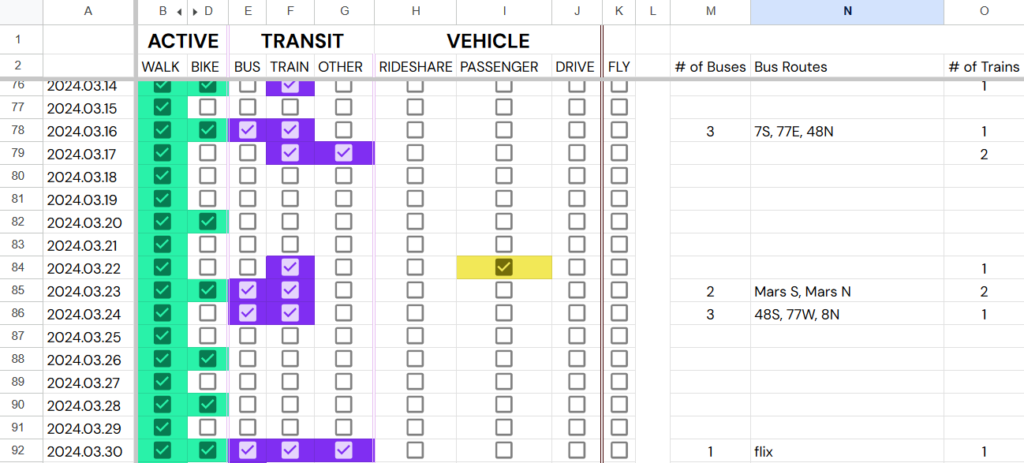
What advice do you have for people who are curious but hesitant to go car free? The first advice I would give is to keep track of how you’re getting around. I made a simple spreadsheet with dates and different modes like Driving (and the reason for driving such as errands, work, healthcare, etc.), Biking, Walking, Transit (you can break it up by bus, light rail, or streetcar if you want to), and Rideshare/Passenger. This is how I realized how little I was using my car.
Another opportunity to explore going car-free is to participate in America Walks’ Week Without Driving challenge. From September 30 to October 6, participants are encouraged to get around without driving themselves to bring attention to walking advocacy and people who are unable to drive. A book I recently read, When Driving Is Not An Option by Anna Zivarts, taught me that 30% of Americans cannot drive due to disability, age (too young or too old), or not being able to afford a car or to drive. I truly think all elected officials should participate in this challenge if they are making decisions about our transportation system, since people who cannot drive are often forgotten. Participating in this challenge can also show you which trips, like socializing, shopping, or commuting, you could try to swap from driving trips to transit or biking trips.
If you have more than one car in your household and all of your cars are not being used to commute to an office or school every day, I would strongly encourage becoming a one-car household. You would still have access to a car when you need it, but you wouldn’t have to pay double for all the costs associated with owning a car.
If you are able to move, I strongly encourage moving to a dense area like a downtown or somewhere along the light rail line, a bike path, or a bus line that will connect you to some of your primary destinations, like work. I chose my spot downtown because it is right next to light rail stations which brought me to my old job. I also recommend locating yourself close to a grocery store, even if it isn’t your preferred store. When I lived near a Safeway in Tempe, I walked there several times a week to grab ingredients I was out of, pick up prescriptions, or get a small load of groceries. Living near a grocery store also allows you to make smaller grocery runs so food doesn’t go bad by the end of the week, and you can choose what you want to eat the same day you buy it.
Lastly, I would encourage people to think more broadly about how they can get around. For example, lots of people can’t imagine not having a car because they like to travel or go on road trips. How often are you actually driving to other places? I found it wasn’t nearly often enough to justify owning a car. Instead, I use FlixBus, rent cars on Turo (allowing me to choose a fuel-efficient car or a larger car for a larger group of people), or just borrow a car from a family member or friend who isn’t using it for the weekend.
Anything else you would like to add? If you ever feel you have a hard time meeting people, living in an area where you can walk and bike will open up many doors and introduce you organically to new friends in your community you would have never met otherwise! Going car-free has encapsulated this for me. Socializing for me can be challenging, but living car-free has made making new friends easier and finding a community I never thought I would have when I moved to Phoenix.
